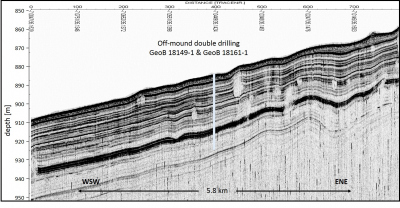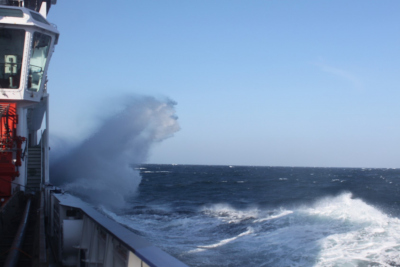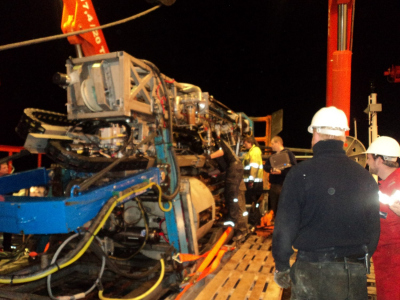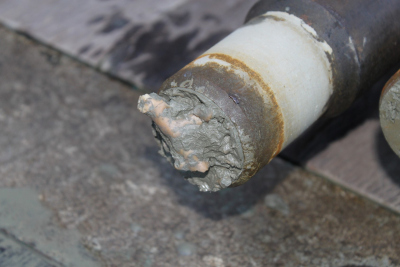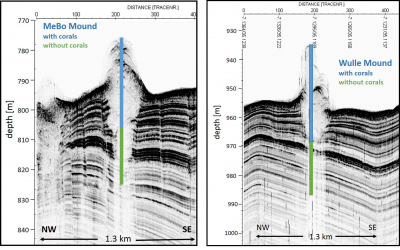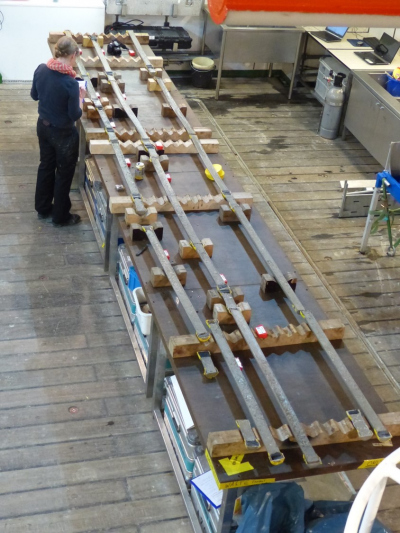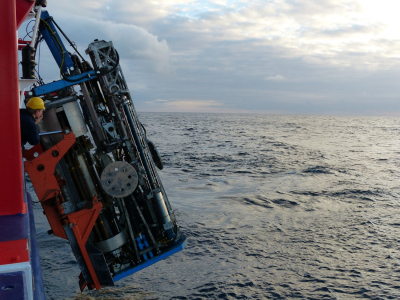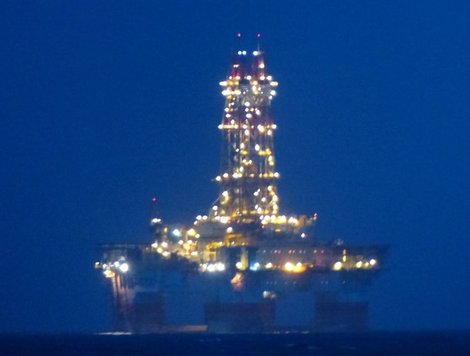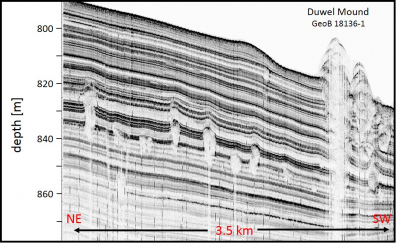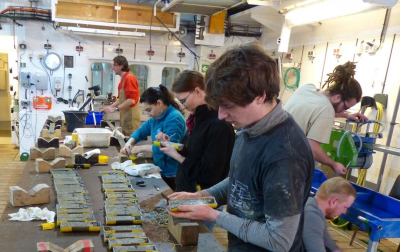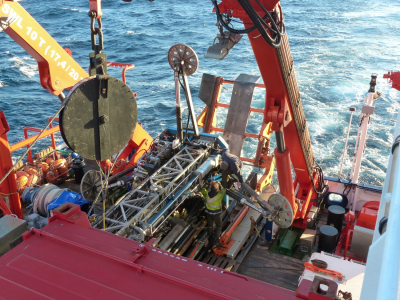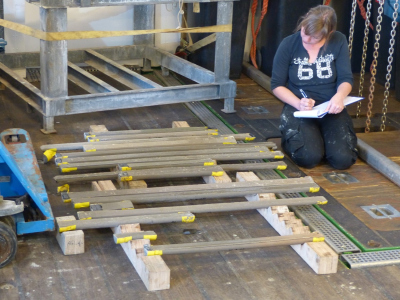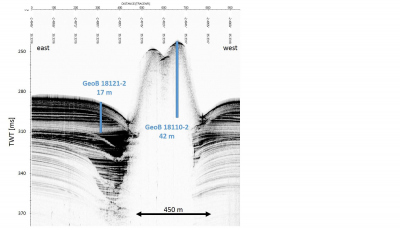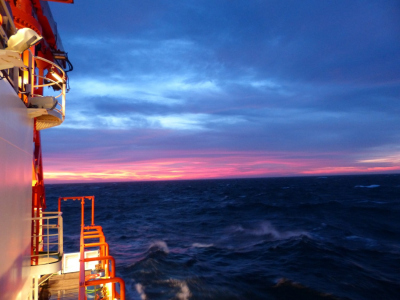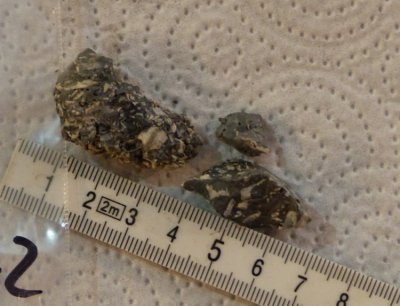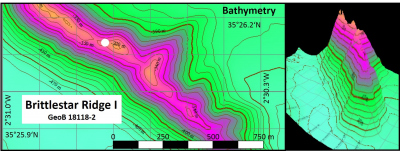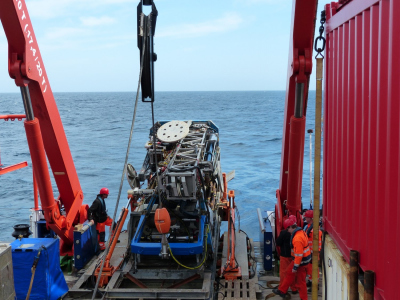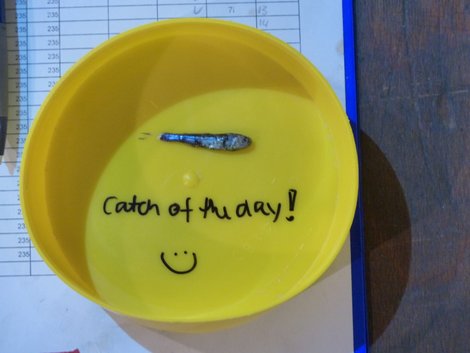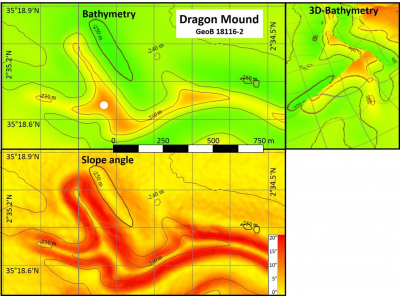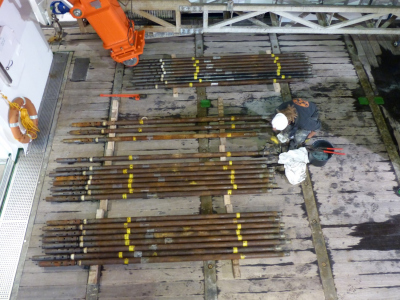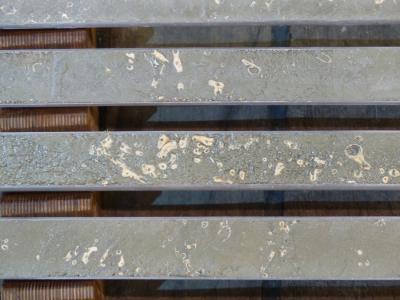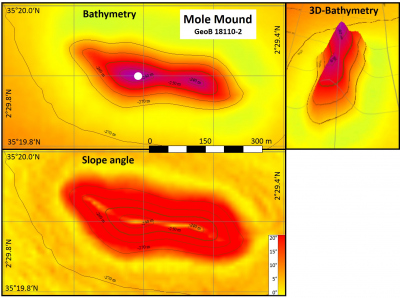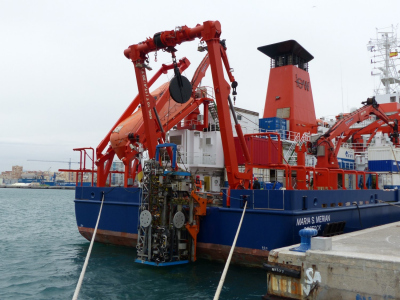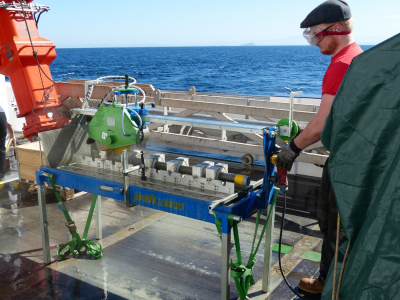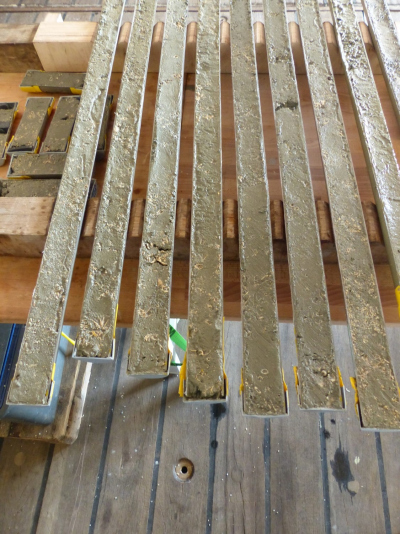Page path:
- Home
- Research
- Expeditions
- 2014
- MSM36
- MeBo-Drilling
First MeBo-drilling through coral mounds

MoccoMeBo - News
RV Maria S. Merian MSM36
(18.02. - 17.03.2014, Malaga - Las Palmas)

Last UPDATE 14.03.2014
In the morning MeBo finished its last mission during this expedition. It came back onboard with yet another 45 m record from an off-mound site, which was the second drilling here in order to obtain a stratigraphically complete paleoceanographic record. This site was strategically placed between a number of buried mounds and most of the seismic reflectors either serving as base for these mounds or covering them have been drilled through. As these reflectors have at least a regional extent interacting with many buried mounds of different generations, this record will tell us quite a bit about the onset as well as the demise of coral growth in this region through time. With this drilling our scientific programme ended. During this cruise we did in total 11 successful MeBo drillings and, in addition with the gravity cores we obtained, we will bring home a sedimentary record of more than half a kilometer in length. This will keep us busy for quite some time and we are eager to start the lab work and to see the first results coming in.
PARASOUND Profile showing the off-mound site, where a successful double drilling yielded two 45 m records. Note the various generations of buried coral mounds around the drill site.

UPDATE 11.03.2014
And yet another main goal achieved: The drillings on Wulle Mound (52 m) and MeBo Mound (45 m) finally went through the entire mound sequences! And they even penetrated a strong seismic reflector that in many places in the region forms the initial base for the coral mounds. Thus, these two records will allow us to decipher the full histories of two of the Moroccan Atlantic coral mounds, one belonging to the group of shallow mounds and one belonging to the deep mounds. The vast quantity of mound structures along the Moroccan Atlantic margin allowed us to select the drill targets according to the MeBo capabilities that in terms of weight ( no. of core barrels and drill rods) these days had to be adjusted to what the weather conditions allowed. Just in time before we got too enthusiastic about the capabilities this expedition offers, we were bypassed by the Maersk Discoverer – what taught us some humility. This is an offshore drill rig able to drill down to 10,000 m that even has its own propulsion and bypassed us with a speed of 8 (!) knots. Thus, while MeBo200 is just in its final integration phase in Bremen, we saw a kind of MeBo10000 …
PARASOUND Profile showing Wulle Mound und MeBo Mound and the reach of the MeBo cores obtained on both mounds

UPDATE 08.03.2014
Well, the Atlantic Ocean is not the Mediterranean Sea. Although the weather conditions in general were pretty good also in our second working area, the Moroccan Atlantic margin, the continuous swell either precludes the deployment of MeBo or at least requires a reduced load (i.e. resulting in shallower drill depths). But, nevertheless, also our first week in the Atlantic saw three MeBo-drillings. The first one, placed at the lower flank of Trappist Mound in 845 m water depth, resulted in a drill depth of 35.6 m with a recovery of 47%. Collected from the lower flank of this mound this record is characterized by intercalated layers of coral-bearing (i.e. mound facies) and coral-barren (i.e. off-mound facies) sediments. The second drilling on Duwel Mound only reached 16.8 m depth (55% recovery) because one of the drill rods got lost and blocked the instrument. Interestingly, this core only contained very few corals although it was taken from a mound cropping out very prominently in the hydroacoustics, where it lines up with quite a number of buried mounds of several generations. The third target, Wulle Mound, was actually visited twice. Right after the first deployment of MeBo, after 8 attempts to land in the rough terrain, an oil leakage was observed and the drilling had to be aborted. However, the next day we came back and after another 14 attempts to land, MeBo finally began to drill.
PARASOUND Profile showing Duwel Mound and a number of buried mounds of several generations

UPDATE 02.03.2014
Our next target was an off-mound site near Mole Mound, where the hydroacoustic data revealed a complex erosion and sedimentation pattern in the moat surrounding Mole Mound. The idea was to sample this record in order to get a full record of the paleoenvironmental forcing that most likely also controls the development of the corals. Unfortunately, the sediment at this site was so soft that MeBo sank partly into it. This caused a problem with the cooling of the motors and after reaching a depth of 16.8 m the drilling had to be stopped. The disappointment did not last long, because even a 16.8. m core would have been far without our reach without MeBo. And with its position very near to the 48 m long Mole Mound record, a nice correlation between coral development and off-mound sedimentation pattern will be feasible. The next day we launched MeBo again on one of the very steep Brittlestar Ridges (this time No. 3). It took “only” 8 attempts to land MeBo safely in a good drilling position. In a drilling depth of 33 m MeBo hit a hardground that it could not penetrate and, thus, MeBo was recovered. As the weather conditions got considerably worse with a poor forecast also for the coming days it was decided to finish the work in the Melilla area and the Merian headed against the wind that blew with 8-9 Bft towards the Strait of Gibraltar to enter the Atlantic and to hopefully begin MeBo drilling there.
PARASOUND section through the two drillings at and near-by Mole Mound.

UPDATE 27.2.2014
After drilling two of the mound structures in the Melilla area we tried to get a long core from our prime target: the Brittlestar Ridge 1, which is a very steep (slope angles mostly vary between 20% and 40%) ridge, rising >150 m above the surrounding sea floor. The most challenging task was to find a suited landing site, where MeBo could be placed stable in an upright position. With its movable legs Mebo can compensate some tilt of the sea floor, but not 20% and more. It took us almost 20 attempts until we finally found a suited position. But finally we were lucky and could begin with the drilling. Only 31 hours later MeBo was revered with another 70 m core. The surprise came when opening the cores: On many of the core liners the top layer was covered by small fishes. These fishes have been swimming around MeBo for hours while it was at the seafloor and somehow the must have find the way into the core barrels. But otherwise, again we got a very interesting cold-water coral record which will help to reconstruct the development of this remarkable seafloor structure.
The steep Brittlestar Ridge I and the MeBo drilling site (white dot)

UPDATE 25.2.2014
In continuing our drilling efforts our next target was Dragon Mound in the southernmost part of the East Melilla cold-water coral province. Dragon Mound is one of the small, ridge-like cold-water coral structures with an elevation of ca. 20 m above the surrounding sea floor. After a smooth landing of MeBo it took roughly 33 hours to drill and recover a 70 m core with almost 100% recovery! After being back on deck the 30 filled core barrels gave an impressive picture. It took us roughly 3 hours to cut, label and store this “bonanza”. When cutting the core in one meter sections it appeared that the lowermost sections do not contain any corals. That would mean that we reached the base of the mound approximately 40 m below the surrounding sea floor and the underlying sediments – one of the key targets of the expedition.
And the story will continue …
And the story will continue …
The drilling site at Dragon Mound

UPDATE 22.2.2014
Already the first attempt to drill one of the coral mounds in the Melilla coral province in the Alboran Sea was successful. On Friday the first drill core could be recovered from the top of a small mound, called Mole Mound, in a water depth of 235 m. The steepness of the mound made the landing of MeBo at the seafloor quite a challenge, but finally MeBo could be placed in a stable position and drilling commenced. After roughly 24 hours of drilling MeBo was recovered and brought a 48 m core on deck. With its total length of 48 m the core GeoB 18110-2 extends well below the topographic base of the mound that has an elevation of 35 m above the surrounding sea floor. The core consisted throughout of the typical coral-sediment mixture typical for these mounds. Over the basal age of the record it only can be speculated by now, but it might well reach back several glacial-interglacial cycles. After cutting the core into 1.2 m pieces these were put to the freezer to prepare them for opening. On Sunday the first frozen cores were opened with a stone saw finally revealing the first glimpse on a long geological cold-water coral record that might serve to answer many questions regarding the long-term development of these corals in the Alboran Sea and about the processes of the formation of these mounds.
Now, MeBo is already back on the sea floor drilling and we hope for more and even longer cores.
Now, MeBo is already back on the sea floor drilling and we hope for more and even longer cores.
The drilling site at Mole Mound



